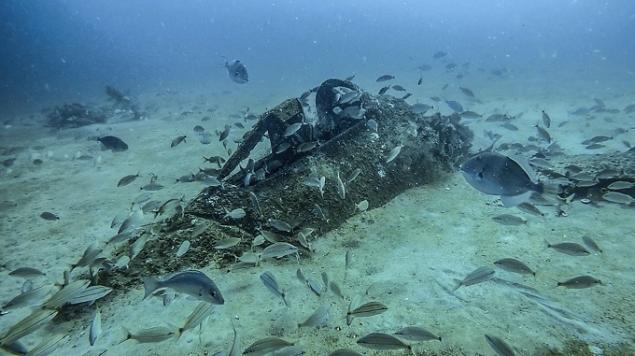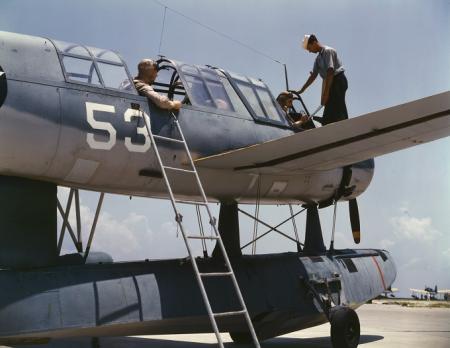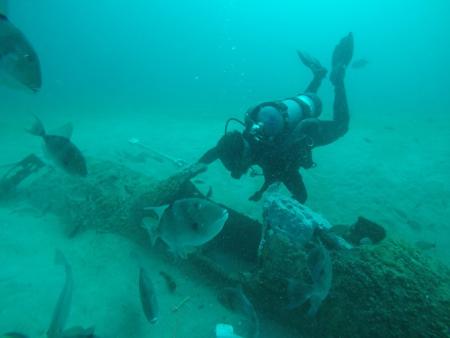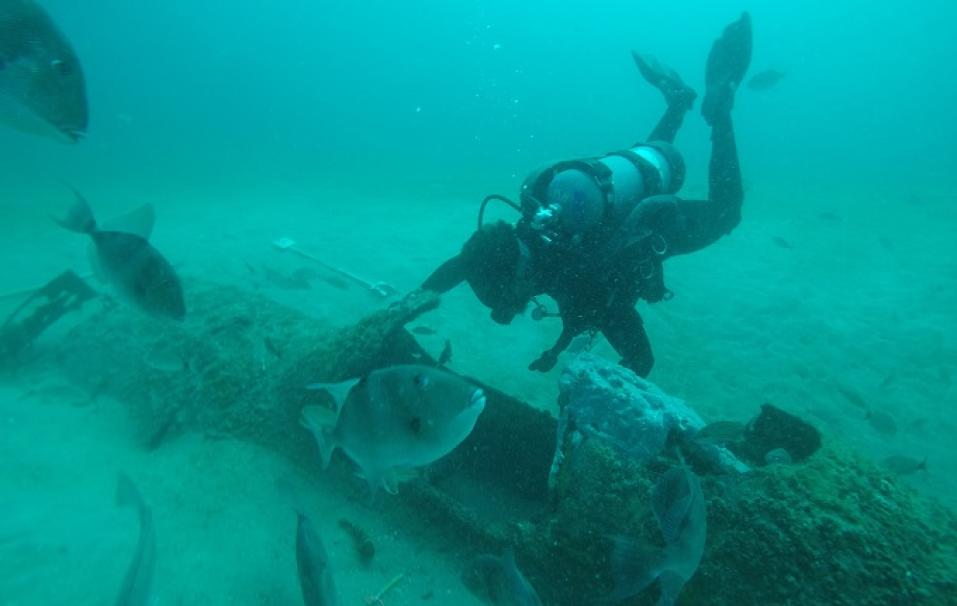By Hunter Whitehead, Marine Archeologist, AerAqua Project (501c) and Amy Borgens, State Marine Archeologist, Texas Historical Commission. Originally posted July 20, 2023.
Often when thinking of underwater archeology, one conjures images of mysterious and fascinating shipwrecks, sometimes those that are famous and significant to state, national, or international history. A rapidly expanding sub-discipline of underwater archeology is the field of submerged aviation—this specialization seeks to chronicle, record, preserve, and present those historic aircraft that have crashed and sunk into watery depths. Though such sites have not yet been rediscovered and archeologically investigated in Texas, the Texas Historical Commission (THC) actively seeks information on these unique sites with the hope of future discovery.

Aviation archeology is a relatively new scientific study of aircraft wrecks and other artifacts related to aviation history. This field of study combines elements of archeology, history, and engineering to understand the causes of aircraft accidents and disasters, as well as the evolution of aviation technology and its impact on society. Aviation archeologists use a variety of methods, such as aerial surveys and underwater remote-sensing investigations, to locate and document aircraft wrecks. By studying these artifacts, researchers can gain a better understanding of the human stories behind aviation accidents and the technological and engineering aspects of aircraft design and construction.
For Texas, the development of aviation and the integration of its commercial and military applications meant broad socioeconomic progress. In 1910, the U.S. Army’s newly formed aviation division relocated to Fort Sam Houston in San Antonio from College Park, Maryland. The decision to relocate to Texas was largely in part due to practical reasons such as the state’s flat terrain and mild climate, which were favorable for flight training activities. The War Department selected Lt. Benjamin Foulois to open the new flight training center along with the Army’s only airplane, known as the Wright S.C. (for Signal Corps) No. 1. Tragedy struck on May 10, 1911, when Lt. George Kelly crashed the Wright S.C. No. 2 while swerving to avoid a crowded troop area. All flight training was immediately canceled, and the program stalled in progress for several years.
In 1917, the ongoing conflict of World War I prompted the development of a dedicated airfield and training program. The Kelly Airfield was founded outside of San Antonio and over 2,000 army pilots were trained at the flight school within the first year. This program would become known as the first Army flight-training center in the nation, and at the time was the largest of its kind in the world.
Military aviation continued as an important aspect of daily life in Texas throughout the 1920s and 1930s, but at a much lower level of activity. Army airfields were installed across the state in places such as Dallas, Fort Worth, Houston, Waco, Wichita Falls, and other locales, bringing the economic benefits of military training facility expansion to those communities. As with World War I, aviation training was vital to the efforts of World War II. Army aviation training facilities ramped up for pilot training across the state, and in 1941 a Naval Air Training Center (NATC) was established in Corpus Christi. By the end of the war, the NATC at Corpus Christi and surrounding auxiliary fields had trained a total of 35,000 naval aviators.

The increase in training activity prompted by World Wars I and II, including post-war training, led to countless aircraft accidents, which sometimes resulted in losses over water. The Texas coastline likely holds the majority of sunken aircraft in the state due to concentrations of flight training in Corpus Christi. Lakes, rivers, and other bodies of water throughout the interior may also have submerged aircraft site potential. Three sunken aircraft are currently listed in the THC’s Marine Archelogy Program (MAP) Shipwreck Database, though more are known: a Martin B-10 bomber in 1941 (THC No. 2385), a Martin B-26 Marauder “Widowmaker” in 1945 (THC No. 2499), and an unspecified military training craft in 1942 (one fatality; THC No. 2500).
The Martin B-10 bomber crashed during a target towing exercise in Matagorda Bay in 1941. Two crew jettisoned from the craft and were rescued after it descended into Matagorda Bay, eventually striking the bay bottom. It was discovered floating on its back and was towed close to shore and abandoned (Veatch 1941). Records of the vessel indicate that in 1988 the tail was visible above the waterline, but later records from 1990 and 1993 only observed a 1-meter square obstruction. The lack of easily recognizable wreckage at this later date may suggest it was unlawfully salvaged, unfortunately. The discovery of this aircraft in Texas would be significant, due to the significance of this particular all-metal monoplane design—which would become the standard worldwide for decades.
The B-26 Marauder “Widowmaker” is another famous type of military World War II aircraft, unfortunately nicknamed due to the high accident rate related to its use. The Texas aircraft crash-landed near the Galveston Army Airfield in December 1944 and was completely demolished in the event, resulting in the loss of all three crew.

There are tens of thousands of aircraft wreck sites in diverse environments around the world, and underwater archeologists have only just begun to scratch the surface of potential research opportunities. Archeological investigations of sunken aircraft sites in Texas will provide a unique perspective into the regional history of aviation, as well as comparative data for archeologists working in other parts of the county and world. The THC has plans to investigate purported claims of a submerged aircraft in the Corpus Christi region and conduct a remote-sensing survey to locate and document additional reported aircraft lost during training missions of the 1940s and 1950s.
Please contact the MAP to share historic accounts and wreck reports: State Marine Archeologist Amy Borgens, 512-463-9504, Amy.Borgens@thc.texas.gov.
Sunken military aircraft are protected as both state-located cultural resources through the Antiquities Code of Texas and as historic government property through the Sunken Military Craft Act. Recovery of sunken historic military aircraft and associated artifacts from state public waters requires antiquities permits from both the Texas Historical Commission and the Naval History and Heritage Command.
References
- Alexander, Thomas E. 2003. The Wings of Change, The Army Air Force Experience in Texas During World War II. McWhiney Foundation Press, Abilene, Texas.
- Ganson, Barbara. 2014. Texas Takes Wings, A Century of Flight in the Lone Star State. University of Texas Press, Austin, Texas.
- Shettle Jr., M.L. 1997. United States Naval Air Stations of World War II, Volume 2–Western States. Schaertel Publishing, Bowersville, Georgia.
- Tarbutton, W. E. 1945. War Diary, Eight Naval District Forces.
- Veatch, Bernard W. 1941. Pilot’s Statement. Lawson Field, Fort Benning, GA. 26 June. THC Files, document provided courtesy of Megan Lickliter-Mundon.

